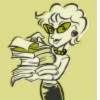 Millman, Isaac. 2004. MOSES SEES A PLAY. New York, NY: Farrar, Straus and Giroux. ISBN 978-0-374-35066-6
Millman, Isaac. 2004. MOSES SEES A PLAY. New York, NY: Farrar, Straus and Giroux. ISBN 978-0-374-35066-6PLOT SUMMARY
In MOSES SEES A PLAY, a class at a special elementary school for children who are hearing impaired prepares to see a play. A class of hearing students also joins them for the occasion. The reader follows the children as they make welcome posters for the actors, watch the play, write thank you letters, and begin doing some acting of their own. The focus of this story is the event of seeing a play rather than the students’ abilities.
CRITICAL ANALYSIS (INCLUDING CULTURAL MARKERS)
Deafness, unique among physical impairments, has its own culture. Isaac Millman creates a story which incorporates deaf culture without overemphasizing the disability itself. MOSES SEES A PLAY fosters acceptance and understanding, incorporates interlingualism, and avoids focusing on the disability; thus creating a sensitive yet valuable peek into deaf culture.
Millman fosters acceptance and understanding throughout MOSES SEES A PLAY. When the hearing children come to Moses’ classroom, both the hearing and non-hearing teachers sit in front of the class reflecting equal authority. Moses also meets a new friend who, like him, does not speak English. Manuel is new to his class and only speaks Spanish. Millman’s correlation between the difficulties experienced by second-language learners and hearing impaired children provides a valuable perspective. “Moses knows how lonely it can be when no one understands you.”
The language used in this story is predominantly English. However, American Sign Language (ASL) is interwoven throughout. This use of interlingualism adds to the flavor deaf culture in the story. Millman includes a “How to” section on making the signs to facilitate the reader’s ability to discern the movements. The use of interlingual ASL also adds an interactive component to read-aloud presentations of this book.
Another positive feature in this book is what its focus is not. Deafness is not the primary subject matter. Moses’ and his classmates’ hearing impairment are details of character development. The characters are not seen as pitiable, nonsexual or even disabled. All of the children participate fully in classroom activities: creating posters, enjoying the play, and acting. When the teacher suggests the children put on a play of their own, one little girl signs, “I want to play Cinderella! And I want [Moses] to be the Prince.” This scene could easily happen in any elementary school classroom—as could Moses’ shocked expression!
This story of a typical class successfully incorporates people with differing abilities, all of whom are capable of “participating fully in everyday life” (Vardell, Lecture Notes, 2007). The story is enjoyable and flows nicely up to its ending. However, the literary quality falters when a wordy, technical description of a communication device is tacked onto the story’s ending.
REVIEW EXCERPTS
“Despite the inclusion of a synopsis of the play, there's not much drama in this story. Small panels showing Moses signing certain phrases are incorporated into the illustrations.” (Horn Book, 2004)
“This book not only familiarizes and sensitizes children to the culture of the deaf or hard-of-hearing community, but also tells an appealing story. Millman draws a parallel between the challenges faced by ESL students and those who do not hear and in so doing raises youngsters' general levels of awareness and empathy.” (School Library Journal, 2004)
Reviews obtained from Follett Library Resources and accessed at:
http://www.flr.follett.com/search?SID=c211074453f514ff63ced2a0fe154f24
CONNECTIONS
Other “Moses” books by Isaac Millman:
MOSES GOES TO SCHOOL, ISBN 978-0-374-35069-7
MOSES GOES TO A CONCERT, ISBN 978-0-374-35067-1
MOSES GOES TO THE CIRCUS, ISBN 978-0-374-35064-2
Other stories about children who have hearing impairments:
Heelan, J. R. and Nicola Simmonds (Ill.). 2002. Can you hear a rainbow? : the story of a deaf boy named Chris. Atlanta : Peachtree Publishers.
Miller, M. B. & George Ancona. 1991. Handtalk schooL. NY : Four Winds.

No comments:
Post a Comment